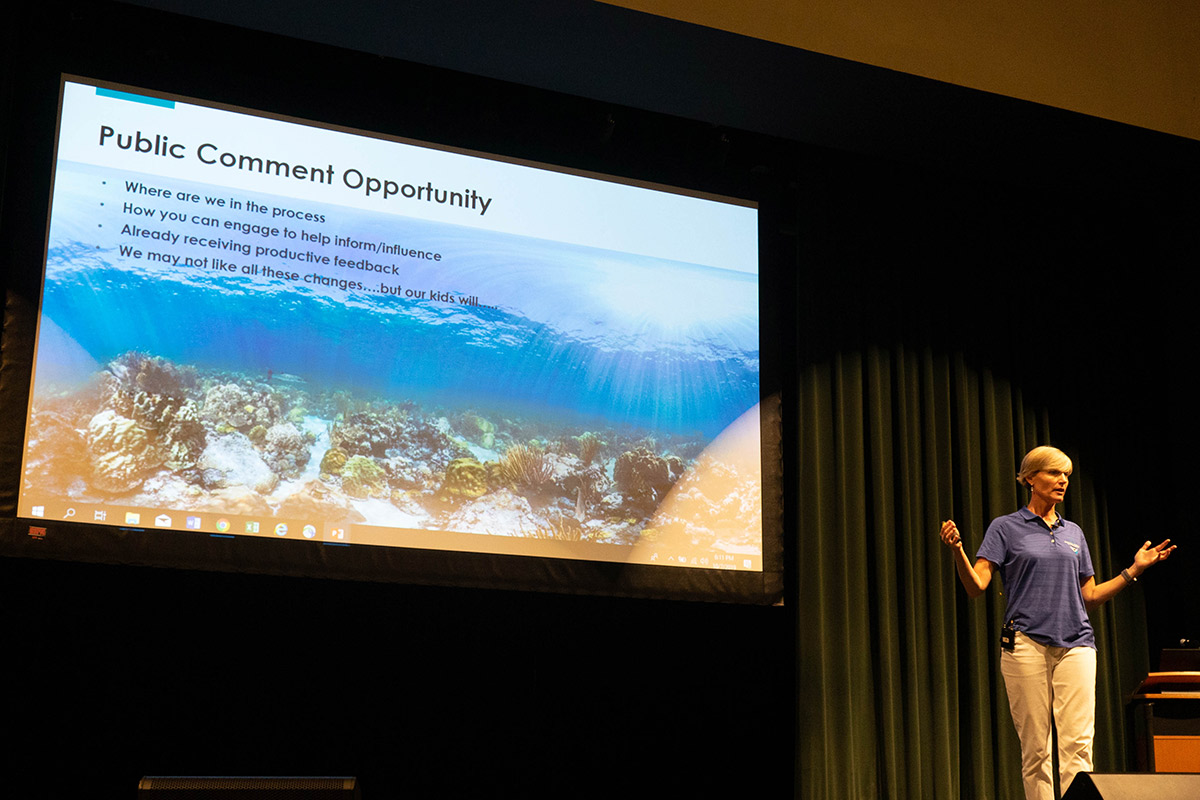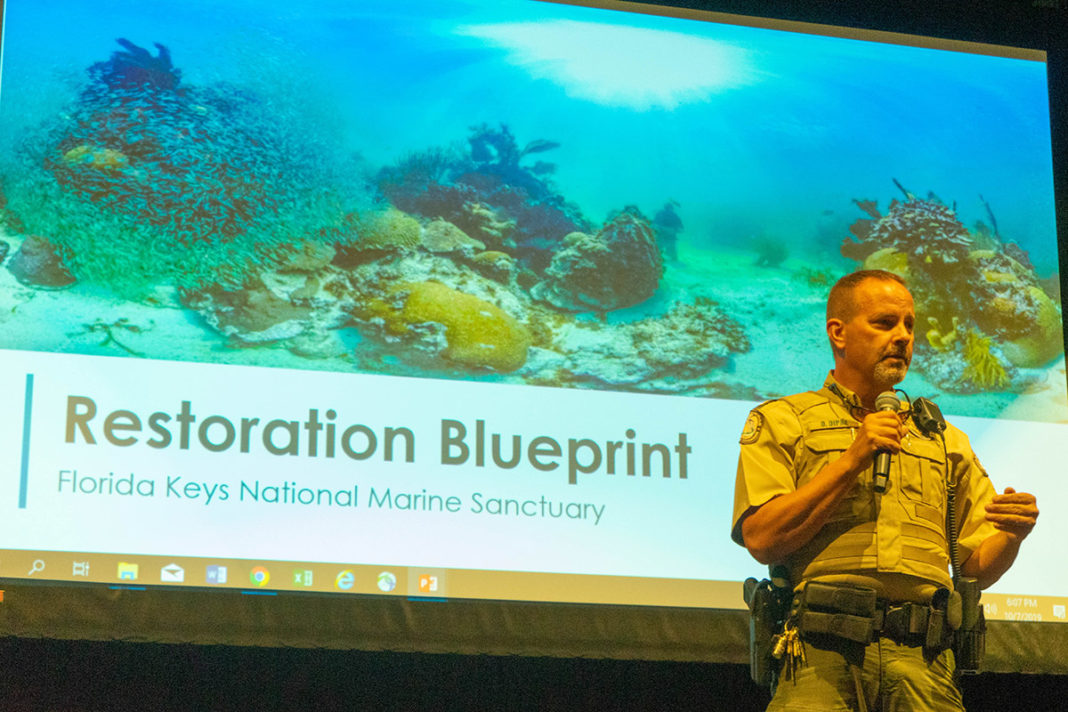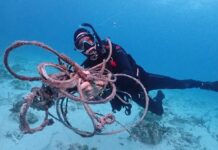On Oct. 7, 230 local residents piled into the auditorium at Coral Shores High School to hear from the Florida Keys National Marine Sanctuary and ask questions about local impacts under the Restoration Blueprint.
Sanctuary Superintendent Sarah Fangman began by stating that the whole purpose of the process is to “recognize that the resources we’re trying to protect are really critical to all of us – for our way of life, our recreation, our income.” She asked each person to make some “difficult choices” and sacrifices with regard to use of these resources to ensure they, and we, have a future.
Sanctuary staff presentations were followed by a two-hour question and answer exchange. “We’ll be here until midnight if needed, no problem,” said Fangman. The forum provided a way for the sanctuary and the public to discuss face-to-face some of the major concerns associated with the blueprint.
It worked for Terry Helmers, a private boater and Keys resident who came to the meeting concerned about the seeming closure of Carysfort and Sombrero reefs. Fangman admitted in her presentation that the original proposal was not clear about what “limited entry” means with regard to local access. She said the absence (of that language) has led people to conclude that “we meant to ban local people. And that’s not what we want at all. That’s not our intention.”
Helmers was relieved. “It was really good she clarified that. That was my really big concern,” he said. “Other than that, I would have liked to see the plan be even more aggressive to regulate or eliminate consumptive uses. We need these reefs to live.”
As in past info sessions, Fangman also addressed three “elephants in the room.” While enforcement and limited use areas — Carysfort, Sombrero and Sand Key — echoed what was said during a forum in Marathon the prior week, in Tavernier, Fangman brought up water quality as the third pachyderm. The regional sources of outflows into Florida Bay make them difficult to stem from within the blueprint’s regulatory framework. She acknowledged this and agreed that making more marine zones can’t fix water quality outright, but pointed out that the plan does call for changes to cruise ship gray water dumping and includes management plan changes to strengthen how the sanctuary can interact with other governmental bodies on regional problems.

During the question and answer, sanctuary scientist Andy Bruckner described the state of the marine environment as a “death of a thousand cuts.” He said there’s no single cause and no single solution for the massive coral die-offs, seagrass losses, and fisheries declines.
“Over the last five years, a litany of things have happened that have harmed our sanctuary,” Fangman said. “It’s very clear to me we don’t have specific proposals in the blueprint to stop hurricanes. We don’t have strategies to overcome global or even regional stressors like warmer ocean temperatures and water quality.
“Does that mean we shouldn’t do something to make our system stronger to face these?” she continued. “I think no. We can’t stop the next Irma, but we’ve got to make our system stronger so it can withstand and bounce back from the next Irma. That’s the opportunity we have here.”
The crowd listened respectfully, but questioned how realistic some of the proposals were and how effective they will be to stop the thousand cuts from bleeding. The sanctuary’s $4.5 million budget was discussed, and Fangman encouraged everyone to write to state representatives and senators in support of the sanctuary to ensure funding remains in place for all these new proposals.
On enforcement, an attendee asked why add more protected zones when the sanctuary “can’t enforce what you already got?” FWC Capt. David Dipre said stronger rules would still better protect the environment even without 100% enforcement. He also suggested requesting state funding to increase the available number of enforcement personnel.
Finally, the new no-anchor zone in the Key Largo Management Area and extension of the SPA into deeper water at Alligator Reef were discussed. Locals queried whether additional mooring balls would accompany new no-anchor zones to ensure continued less-destructive access to the reefs. Bringing up missing moorings in Islamorada, they also wondered if resources existed for upkeep of current and new moorings. Fangman assured the audience that the sanctuary knew the moorings needed to be updated and modernized, and that more would indeed be added. Bruckner explained that the no-anchor zones will protect corals from further damage and that the SPA extensions will protect key commercial fish species throughout their life cycles. In this way, he added, they hope to accomplish greater holistic ecosystem restoration.
Fangman reframed the blueprint not as a final plan, but rather as a starting place for productive discussions with the community. Fangman hopes the public comment process will facilitate a mutually-beneficial knowledge exchange about how to balance protection and use. Assuring the crowd that sanctuary staff is listening, she added, “people won’t support something they don’t feel a part of, so for sure we are taking your inputs into account.”
More information on the Restoration Blueprint including interactive maps is at floridakeys.noaa.gov/blueprint.
Public comments can be submitted in-person, online, and by mail through Jan. 31, 2020. To provide online public comment, visit regulations.gov and search docket number “NOAA-NOS-2019-0094.”
























